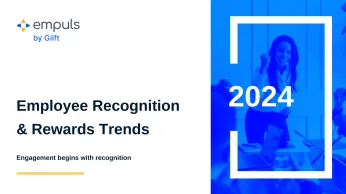En esta página
- What is recognition?
- What is gratitude?
- Why is it important to create a culture of recognition and gratitude in the workplace?
- Benefits of building a culture of recognition and gratitude in your workplace
- 10 Ways to create a culture of recogniton and gratitude in the workplace
- How Empuls fuels a culture of recognition and gratitude
Imagine walking into work every day knowing your contributions matter—that your effort isn’t just noticed, but genuinely appreciated. That’s the power of a culture of recognition and appreciation.
And it couldn’t be more relevant today. In a recent survey by McKinsey, 40% of employees reported they were likely to leave their current job in the next 3–6 months, as the Great Resignation shows no signs of slowing down. Employees are no longer just chasing paychecks—they’re seeking purpose, belonging, and to feel valued in their work.
This is where building a culture of gratitude becomes your secret weapon. It’s not about one-off perks or token gestures. It’s about making gratitude and recognition a daily ritual—woven into the way teams collaborate, celebrate, and grow together.
So, how do you create a culture of recognition that doesn’t feel forced or forgotten? One that energizes people, boosts retention, and inspires them to do their best work?
This blog is your blueprint. Let’s explore why recognition and gratitude matter more than ever—and how to make them the heartbeat of your workplace culture.
What is recognition?
Recognition, in general, is acknowledging all the positive things in life, such as the goodness in other people, events, and experiences. Employee recognition acknowledges employees' inherent value, not just their work performance.
Building a culture of recognition involves acknowledging the contribution of employees for their meaningful impact on the bigger picture. Whether it is thanking them for a job well done or recognizing their efforts to help other departments or a member in need, employee recognition encompasses it all.
What is gratitude?
Gratitude, a close sibling of recognition, takes a step further to recognize the influence of outside forces on our success.
The word gratitude is derived from Latin and means 'thankfulness'; therefore, it can also be thought of as a 'thankful recognition.' Gratitude in the workplace is the foundation of trust, empathy, and communication, all of which are the most sought-after attributes of a strong organizational culture.
Why is it important to create a culture of recognition and gratitude in the workplace?
Human beings are social animals, and relationships are fundamental to any group structure–be it a family, a group of friends, or colleagues. Unfortunately, in the middle of hectic work cycles, employees get little time to bond to the team and organization in productive ways.
A culture of recognition and gratitude fills in the gaps by engaging employees in thank-you activities that build trust while making them feel valued. At an organizational level, a culture of recognition and gratitude is closely tied to productivity, engagement, and employee retention.
Benefits of building a culture of recognition and gratitude in your workplace
Building a culture of recognition goes beyond handing out praise—it's about creating a workplace where people feel seen, valued, and motivated to do their best. Here are a few key benefits that come with making recognition part of your everyday work culture.
1. Puede aumentar la moral de los empleados y la satisfacción en el trabajo
When the employees of an organization are appreciative of one another, it has the effect of lifting employee morale. It motivates them to work as a team and improves job satisfaction on the whole.
2. Reduce el estrés y el absentismo laboral
Una cultura de la gratitud hace que los empleados se sientan valorados, reduciendo la inseguridad laboral y el estrés asociado a ella. La disminución de la tensión en el entorno laboral también reduce las bajas por enfermedad y anima a las personas a acudir a su trabajo.
3. Aumenta la productividad de los empleados
Los empleados que son apreciados regularmente por sus jefes y compañeros tienen más confianza y están más comprometidos con su trabajo. Estos empleados felices están dispuestos a rendir más y a mantener su papel de empleados valiosos.
4. Aumenta la retención de los empleados
Productive and engaged employees with the strong work culture of gratitude are satisfied with their job. Moreover, having such stability and nurturing atmosphere at work can significantly reduce employee turnover.
5. Ayuda a atraer el talento
Una cultura de trabajo sólida convierte a los empleados en embajadores de la organización, lo que contribuye a los esfuerzos de contratación. Además, el boca a boca de los empleados satisfechos mejora la propuesta de valor del empleador y atrae a los mejores talentos.
10 Ways to create a culture of recogniton and gratitude in the workplace
The key to unlocking higher levels of engagement, happiness, and productivity in the workplace lies in creating a culture of appreciation and gratitude. So, here are some important tips on how to build a culture of appreciation and gratitude at work:
1. Enviar rápidamente notas y correos electrónicos de agradecimiento
Whether for closing a deal, securing new business, achieving goals, or generating new ideas, make it a habit to send thank you notes and emails. Being prompt with your appreciation shows your employees that you are grateful for their efforts and value their presence in the workforce. To make it highly effective, send out the email immediately after an event or write a hand-written note to make it extra memorable.

Automate thank-yous and milestone celebrations with ease
Why wait to say thanks? Empuls makes it easy to send automated appreciation messages and gifts for birthdays, work anniversaries, project completions, and more. With built-in workflows and smart nudges, you can ensure that no moment of recognition slips through the cracks.
Learn More
2. Personalice su enfoque de la apreciación
El agradecimiento es más eficaz cuando se entrega de forma muy personalizada. Aunque la personalización por sí misma tiene un fuerte impacto, apreciar a los empleados de la forma en que les gusta ser apreciados puede marcar la diferencia.
Por ejemplo, mientras que algunos se alegran con una simple nota de agradecimiento, otros esperan un regalo tangible o un reconocimiento público por su éxito. La forma de averiguar su lenguaje de agradecimiento es observar cómo aprecian a los demás. Los directores y jefes de equipo tendrán una visión personalizada de los miembros de su equipo que puede determinar la mejor manera de apreciar a cada individuo.
3. Celebrar tanto las grandes como las pequeñas victorias
Celebrar las grandes victorias es necesario para romper la monotonía de las largas duraciones de los proyectos y devolver a los empleados una mayor pasión, entrega y concentración. Las grandes celebraciones son también un momento para que los empresarios sean creativos con sus recompensas. Las pequeñas victorias también merecen ser celebradas, ya que construyen el camino hacia las grandes victorias.
El secreto para mantener la moral es dividir la tarea en trozos del tamaño de un bocado y agradecer con frecuencia cada pequeña victoria. Las pequeñas y frecuentes palmaditas en la espalda son las que mantienen a los empleados alerta para seguir siendo productivos.

Celebrate wins—big and small—with visibility
Empuls’ company-wide social feed turns individual accomplishments into collective celebrations. From shoutouts to wishboards, every win can be broadcast to boost morale and motivate others to follow suit.
4. Incorporar la gratitud al liderazgo
Los líderes de la dirección de una organización son responsables de guiar a los individuos y a los equipos hacia los objetivos de la organización. Sin embargo, con el estrés y la ansiedad de ser reactivos al dinámico panorama empresarial, los líderes rara vez tienen tiempo para apreciar a sus equipos.
Esta situación se ve agravada por la falta de confianza de muchos empleados en la dirección. Los directivos pueden reforzar la moral y la confianza de los empleados celebrando sesiones informativas de agradecimiento tras la finalización del proyecto y agradeciendo activamente a todos su contribución de forma periódica.
Since implementing this personalized approach, we've observed a 35% increase in employee engagement and a 25% decrease in turnover rates. This strategy has also positively impacted our customer relations, with a 20% boost in repeat customer interactions. These figures underscore the significance of a leadership style that's not just about guiding, but genuinely appreciating each individual's contribution to our collective success.
5. Haz que la gratitud forme parte de tu narrativa
Your social media posts, blog content, podcasts, vlogs, and newsletters form the narrative about your organization. Weaving gratitude into your stories is a component of building a culture of employee appreciation. Include stories that talk about the contribution of your employees to your success in a tone that is highly appreciative and grateful. Talk about gratitude as part of the organization’s culture from the top down and across.
6. Crear oportunidades para expresar la gratitud
Para crear una cultura de la gratitud, todo el mundo debe tener la oportunidad de participar. El cambio puede producirse en forma de reuniones informales cada mes o cada semana en las que todos se turnan para expresar su gratitud a individuos o a todo el equipo.
Other exercises can include writing a gratitude journal, leaving anonymous gratitude notes on a notice board, or gratitude box entries for something good that happened at home or work. Employee rewards and recognition programs established by organizations are also a great way to reinforce a culture of appreciation.
7. Destacar las mejores cualidades de los individuos
La creación de una cultura de apreciación de los empleados está incompleta si no se destaca al individuo. Apreciar las mejores cualidades de los empleados individuales es una de las formas, si no la más poderosa, de sacar lo mejor de la persona.
Apreciar cualidades poco reconocidas como la honestidad, la admisión de errores y la voluntad de aprender y cambiar. Un ejercicio en la misma dirección podría ser dar turnos a cada empleado para que se siente en el "asiento caliente de la apreciación" mientras los miembros de su equipo van hablando de sus mejores cualidades.
8. Agradece a los que rara vez son apreciados
Todas las organizaciones tienen empleados a los que rara vez se les reconoce su trabajo, que mantiene la maquinaria de la organización funcionando sin problemas. Se trata de personas que trabajan en funciones de apoyo, como el personal de TI, RRHH, contabilidad, mantenimiento y conserjería.
Darles las gracias periódicamente es fundamental para crear una cultura del aprecio, ya que pone de manifiesto la interdependencia de los distintos departamentos de una organización. Si eres auténtico al agradecer a los héroes olvidados, aumentarás la moral de todos los miembros de la organización.
9. Promote peer-to-peer appreciation
Although appreciation by the managers and leaders is significant, peer-to-peer appreciation has a more profound impact. Employees in every team share a sense of comradery and the highest honor one can receive is to be recognized and thanked as an important team member. Establishing peer-to-peer recognition programs can solidify your efforts toward building a culture of appreciation and gratitude.
Empuls empowers everyone to participate in creating a culture of gratitude through peer-to-peer recognition tools. Employees can give kudos, send hi-fives, and nominate peers for awards—strengthening camaraderie and trust across teams.
10. Build a culture of appreciation in the workplace
Employee recognition is central to creating a culture of appreciation at the workplace. Recognition of employees involves recognizing not only the outcomes but also the efforts and the progress.
Public recognition in the form of company-wide shoutouts boosts the morale and self-esteem of employees. Recognition can take the form of congratulating on completing projects, reaching milestones, or even a simple “thank you.”
How Empuls fuels a culture of recognition and gratitude
Want to make recognition second nature at your workplace? That’s where Empuls steps in.
Empuls isn’t just another HR tool—it’s your all-in-one sidekick for sparking joy, boosting morale, and creating those "you matter" moments across the organization. It makes recognizing and rewarding your team as easy (and fun) as sending a GIF.

Here’s how Empuls helps you build a culture where gratitude flows and recognition shines:
- Recognize in real time With smart nudges and seamless workflows, Empuls makes it easy to appreciate someone the moment they go above and beyond—no more “I’ll thank them later” moments.
- Make every milestone magical: Birthdays, work anniversaries, service milestones—you name it, Empuls celebrates it. From automated wishes to curated rewards, it's all taken care of.
- Peer-powered positivity: Give everyone a voice. Empuls enables peer-to-peer shoutouts, hi-fives, and appreciation badges, turning teammates into cheerleaders.
- Recognition that’s actually rewarding: Choose from a global catalog of gift cards, experiences, wellness perks, charity options, and more. Recognition becomes personal, memorable, and meaningful.
- Let AI do the heavy lifting: Em, the AI assistant, helps managers spot recognition gaps so that no one feels left out. It’s like having a gratitude compass built right into your culture.
Put recognition in the spotlight: From townhalls to social feeds, Empuls turns recognition into a shared celebration. Everyone sees it, feels it, and wants to be a part of it.
Book a demo with Empuls today and start turning everyday moments into reasons to celebrate.
Reflexiones finales
As social animals, we are wired for acceptance, recognition, and gratitude from our peers. To establish a culture of gratitude, it is essential to start from the top-level management and let it trickle down to teams and individuals.
A culture of recognition takes time to establish, but once embedded, it builds trust, strengthens teams, and fosters lasting engagement. Over time, people begin to believe in it—and that’s when it becomes a true culture, not just a practice.













